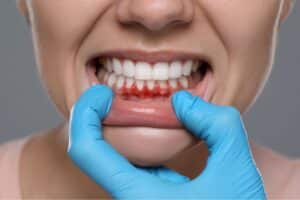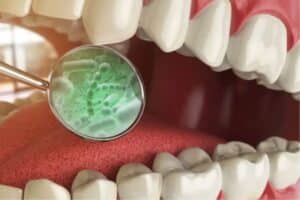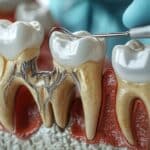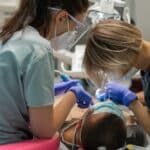Gum Disease Awareness and the Role of Dental Implants
As with many other health problems, prevention is the best way to deal with the threat of gum disease, also known as periodontal disease or periodontitis. This is why dental professionals encourage everyone to adhere to an oral hygiene routine that includes daily brushing and flossing as well as scheduling regular dental checkups.
But many people find themselves dealing with advanced gum disease for one reason or another. Some are born with a genetic predisposition to it. Others may have followed a busy lifestyle that led them to place a low priority on oral hygiene and regular dental visits. Still others may not have been exposed to education regarding the importance of brushing and flossing until their gums were too far diseased for a simple oral hygiene regimen to repair the damage.
For those with advanced periodontal disease that has resulted in loose, rotten and missing teeth, replacement teeth anchored by dental implants are often the best solution. In this article, we’ll explore the causes and effects of periodontal disease as well as how to know when full mouth dental implants may be the ideal solution.
Exactly what is periodontal disease?
The term “periodontal” comes from the Greek word “peri,” which means “support,” and “odous,” which means “tooth.” When dental professionals diagnose you with periodontal disease, they’re referring to a chronic inflammation of the tissues that support your teeth – typically your gums, but in advanced stages, the damage may extend to the jawbone as well. Bacterial infection is the most common cause of gum inflammation.
Gum disease is one of the most common health conditions in the United States, where about half of all adults have some form of it. Although periodontal disease can cause plenty of discomfort, including sore and bleeding gums, many people begin to take notice only when it affects their teeth. Notably, advanced gum disease is the leading cause of tooth loss.

What causes gum disease?
The primary cause of gum disease is dental plaque buildup. Plaque is a sticky film created by food particles and saliva that adheres to your teeth and harbors bacteria. It’s normal for plaque to form on your teeth. But it’s also necessary to remove it through brushing, flossing and periodic professional cleanings to prevent not only gum disease but also tooth decay.
If allowed to linger, the bacteria in plaque can irritate the gum tissue around the base of your teeth – a part of the gums known as the gingiva. This can cause inflammation and potentially a bacterial infection. Failure to treat this condition in its early stages can allow the infection to spread to the bony tissue in which teeth are rooted, which typically leads to loose teeth that eventually fall out.
Failure to routinely remove dental plaque is the top cause of periodontal disease. However, it’s worth noting that some people have an inherited predisposition to severe gum irritation that can lead to early-onset periodontitis, a highly advanced form of gum disease that causes tooth and gum loss.
Tobacco use, excessive alcohol consumption and poor nutrition have also been shown to accelerate the development of advanced gum disease.
Signs and symptoms of gum disease
Red, sore and bleeding gums are the most common signs of early periodontal disease. As the condition progresses, symptoms may also include:
- Pain when chewing food
- Gum recession, including the formation of small pockets around your teeth
- Loose and weakened teeth
- Changes in the way your teeth fit together
- Bad breath (halitosis)

4 stages of gum disease
If you’re considering replacing your teeth with dental implants because you’re experiencing problems with your gums, it’s helpful to be aware of how periodontal disease typically progresses. Most dentists and periodontists recognize the following stages:
- Gingivitis – In its earliest stage, gum disease causes red, puffy gums that tend to bleed when you brush or floss. At this stage, the condition is considered to be reversible with general dentistry treatment
- Mild periodontitis – This stage occurs when bacteria have penetrated the gums and started to infiltrate the underlying bone. The gums pull away from the teeth, creating small pockets where bacteria can collect and evade removal by brushing and flossing.
- Moderate periodontitis – If left untreated, gum disease worsens as bacteria start to break down ligaments and soft tissue that hold the teeth in place. Signs often include bad breath and pus accumulating around the gum line.
- Advanced periodontitis – A severe form of gum disease, this stage weakens the jawbone, causing teeth to become loose and eventually fall out. Without teeth and the pressure they create during chewing, the jawbone tissue is no longer stimulated to form new cells. Over time, the bone mass will shrink, causing structural changes in the face and potentially posing challenges for the placement of dental implants.
At New Teeth Now, our patients are often in the advanced gum disease stage and may have been told that full mouth dental implants are not feasible for them, or their bone mass has diminished to the point they must undergo bone grafting before getting implants. Fortunately, our highly skilled oral surgeons have vast experience in treating patients with advanced periodontal disease. For example, patients with severe bone loss in the upper arch are likely to benefit from the placement of zygomatic implants, which are implants that anchor into the cheekbone – or zygoma – instead of the jawbone.
When is it too late to reverse gum disease?
Technically, the effects of gum disease can’t be reversed once the condition progresses beyond the gingivitis stage. In the mild and moderate periodontitis stages, the detrimental effects can be managed through treatment, and the disease progression can often be halted.
However, once advanced periodontal disease has led to bone loss, the effects can’t be reversed. Patients likely face the prospect of tooth replacement, with options ranging from removable devices like dentures to permanent solutions like dental implants.
Can you get dental implants with bad gum disease?
In most cases, advanced periodontitis won’t keep you from getting dental implants at New Teeth Now. In fact, for those whose gum disease has progressed to the point that they have significant tooth loss or decay, full mouth restoration with dental implants and custom-crafted, natural-looking teeth may be the ideal solution.
At New Teeth Now, we offer a one-and-done solution to tooth loss caused by periodontitis because we remove the gum disease and extract any remaining teeth at the same time we place full arch or full mouth dental implants. Even for patients whose advanced gum disease has caused drastically diminished bone mass, our board-certified oral surgeons can usually create a treatment plan that replaces their teeth without resorting to costly, time-consuming bone grafts.
In fact, the oral surgeons at New Teeth Now have extensive experience in treating highly complex cases, and they’re among the most experienced in the world at placing zygomatic implants.
In addition to zygomatic implants, New Teeth Now offers a full slate of restorative dentistry services using cutting-edge digital tools. Whether you turn to us for zygomatic implants or traditional “all-on-X” full mouth implants, you’ll receive a customized treatment plan that benefits from our high-tech, on-site imaging services as well as the unparalleled expertise of our renowned oral surgeons.
Another way we excel at delivering the highest patient experience in the dental implant industry is by performing our procedures using general anesthesia, the best sedation option to ensure that our patients feel no pain. We also have an on-site restorative dentistry lab, which means our patients can receive their implants and go home with beautiful new teeth on the same day.

Are dental implants your best solution for periodontal disease?
The answer to this question depends on your unique situation, including the extent of your tooth loss and other damage caused by long-term periodontal disease. At New Teeth Now, we take pride in the thousands of patients we’ve helped regain their confidence and change their lives through our dental implant services, and most of those patients had chronic periodontal disease.
We’ll be happy to answer your questions and help determine whether you’re a candidate for full arch or full mouth dental implants at one of our state-of-the-art clinics in Florida or California. Contact us today to schedule a consultation.









